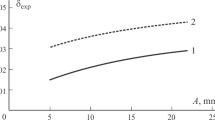A method for identification of the elastic and damping properties of soft materials in tension–compression and shear in a composition with a rigid (base) material is proposed. The method is based on the analysis of the lowest free vibration frequencies and amplitude dependences of internal damping parameters of three-layer test specimens of an appropriate structure: the base material is placed in the middle of the specimens for tension–compression, but as outer layers for shear. Identification of the elastic properties in tension−compression and shear is based on a comparison of calculated and experimental frequencies of corresponding test specimens. It is shown that the elastic properties found for a technical rubber depends on vibration frequencies of the test specimen. A quadratic functional containing experimental and calculated parameters of internal damping of test specimens is employed to identify the damping properties of soft materials. A three-layer finite element developed for this purpose is proposed for a numerical evaluation of the design parameters of internal damping of a three-layer test specimen. Calculations were carried out to identify the damping characteristics of the technical rubber in tension–compression and shear from the parameters of internal damping of test specimens with a D16AT aluminum alloy as the base material.














Similar content being viewed by others
References
A. I. Golovanov, V. I. Mitrjajkin, and V. A. Shuvalov, “Calculation of the stress-strain state of the torsion bar of helicopter rotor,” Proceedings of High School. Aviation Technics, No. 1, 66-69 (2009).
V. N. Paimushin and V.M. Shishkin, “Modeling the elastic and damping properties the multilayered torsion bar-blade structure of rotors of light helicopters of the new generation. 1. Finite-element approximation of the torsion bar,” Mech. of Compos. Mater., 51, No. 5, 861-888 (2015).
V. N. Paimushin and V. M. Shishkin, “Modeling the elastic and damping properties the multilayered torsion bar-blade structure of rotors of light helicopters of the new generation. 2. Finite-element approximation of blades and a model of coupling of the torsion bar with the blades,” Mech. Compos. Mater., 51, No. 6, 1095-1118 (2015).
R. D. Adams, “The damping characteristics of certain steels, cast irons and other metals,” J. of Sound and Vibration, 23, No. 2, 199-216 (1972).
BS ISO 4664−2 Rubber, vulcanized or thermoplastic: Determination of dynamic properties, London: British Standards Institution (2006).
J. G. Panovko, Internal Friction at Vibrations of Elastic Systems, Moskow: Fizmat. Lit. (1960).
G. S. Pisarenko, Vibrations of Mechanical Systems with Account of Imperfect Elasticity of Materials, Kiev: Naukova Dumka (1970).
C. Zener, Elasticity and Inelasticity of Metals, Moscow: Inostrannaja Lit. (1954).
R. M. Christensen, Theory of Viscoeleasticity, N.Y.: Academic (1974).
V. G. Dubenets and V. V. Khil’chevskii, Vibrations of Damped Composite Structures, Kiev: High School (1995).
G. S. Pisarenko, A. P Jakovlev., V. V. Matveev, Vibrarion Absorption Properties of Structural Materials: Handbook, Kiev: Naukova Dumka (1971).
H. Oberst and K. “Frankenfeld Uber die damfung dunner bleche durch festhaltende belage,” // Acustica, 2, No. 4, 181−184 (1952).
ASTM E-756, Standard Test Method for Measuring Vibration-Damping Properties of Materials, Am. Soc. for Testing and Materials (2004).
V. N. Paimushin, V. A. Firsov, I.Günal, and A. G. Egorov, “Theoretical-experimental method for determining the parameters of damping based on the study of damped flexural vibrations of test specimens. 1. Experimental basis,” Mech. of Compos. Mater., 50, No. 2, 127-136 (2014).
V. N. Paimushin, V. A. Firsov, I. Gyunal, A. G. Egorov, and R. A. Kajumov, “Theoretical-experimental method for determining the parameters of damping based on the study of damped flexural vibrations of test specimens. 3. Identification of the characteristics of internal damping,” Mech. of Compos. Mater., 50, No. 5, 883-902 (2014).
E. Sorokin With. To the Theory of Internal Friction at Vibrations of Elastic Systems, Moscow: Gosstrojizdat (1960).
V. A. Pal’mov, Vibrations of Elastoplastic Bodies, Moscow: Nauka (1976).
A. M. Kamalutdinov and A. G. Egorov. ”Determination of the coefficient of aerodynamic resistance of harmoniously vibrating thin plate,” XI All-Russian Congress on fundamental problems of theoretical and applied mechanics, Report Collection, August, 20-24, Kazan, 1693−1695 (2015).
V. N. Paimushin, V. A. Firsov, I. Gyunal, and V. M. Shishkin, “Identification of the elasticity and damping characteristics of a fiberglass based on a study of dying flexural vibrations of test samples,” Mech. of Compos. Mater., 51, No. 3, 285-300 (2015).
T. Shoup, A Practical Guide to Computer Methods for Engineers, Prentice Hall (1979).
R. W. Clough and J. Penzen, Dynamics of Structures, N.Y: McGraw Hill, (1975).
V. P. Kandidov, S. S. Chesnokov, V. A. Vysloukh, Method of Finite Elements in Dynamics Problems, Publishing House of Moscow University (1980).
V. V. Khil’chevskii and V. G. Dubenets, Energy Dissipation at Vibrations of Thin-Walled Elements of Structures, Kiev: High School (1977).
Acknowledgements
This research is performed according to a grant of the Russian Scientific Fond (project No. 14-19-00667).
Author information
Authors and Affiliations
Corresponding author
Additional information
Translated from Mekhanika Kompozitnykh Materialov, Vol. 52, No. 4, pp. 615-644 , July-August, 2016.
Rights and permissions
About this article
Cite this article
Paimushin, V.N., Firsov, V.A., Gyunal, I. et al. Identification of the Elastic and Damping Characteristics of Soft Materials Based on the Analysis of Damped Flexural Vibrations of Test Specimens. Mech Compos Mater 52, 435–454 (2016). https://doi.org/10.1007/s11029-016-9596-x
Received:
Published:
Issue Date:
DOI: https://doi.org/10.1007/s11029-016-9596-x




